Aylesbury Vale Area Design Supplementary Planning Document
9. Building conversions
9.1 Agricultural building conversion
Principle DES64: Conversion of traditional agricultural buildings
The primary objective of all conversions of traditional agricultural buildings must be to retain the character and appearance of the original building.
Consideration and a careful design response should also be given to the relationship of the building with the surrounding landscape and in particular trees which may make a positive relationship to the buildings setting or impact on the local environment through casting shade.
Where conversion to residential use is proposed this may require compromises in terms of the residential layout and the provision of natural light into all habitable rooms.
The simplicity of traditional farm buildings should be retained in any conversion. It is desirable not to disturb roofs in any way at all and conversions should re-use existing door and window openings and avoid introducing new window and door openings especially on the public facing side. Any new openings should be appropriately proportioned to respond to the original building.
Building materials and the wider public realm design should be sympathetic with the character of the building.
Rebuilding should be avoided whenever possible and, if required, conversions should re-use existing materials and avoid modern replicas.
The introduction of conspicuous domestic features such as chimneys, satellite dishes, aerials, porches and conservatories tend to be out of character with the original building and, wherever possible, such features should be avoided. Rainwater goods should be discretely located.
Internal walls should be retained wherever practically possible and the introduction of additional internal walls kept to a minimum. Timber roof trusses should be retained and not cut or removed to provide head height at first floor level.
When converting a building to domestic use it is important that the design and materials used enable sufficient noise insulation. This is particularly important when a building conversion creates a mix of domestic and commercial uses in close proximity.
A structural report will need to be submitted with any planning application to demonstrate that the building is capable of conversion without substantial rebuilding or extension.
Old farm buildings can support protected species such as bats and barn owls. Bats and their roost sites are highly protected under the Wildlife and Countryside Act 1981 (as amended) and The Conservation of Habitats and Species Regulations 2017. Barn owls are protected against disturbance whilst they are nesting. Applications will need to be supported by appropriate surveys

Figure 9.1: Conversion of a traditional farm buildings
Reason
9.1.1 Traditional farm buildings either as stand alone building or groupings of buildings can be delightful structures with individual charm and grandeur, yet typically they are simple, straightforward buildings constructed by local workmen with local materials.
9.1.2 Continuation of the original agricultural use is usually most appropriate to preserve the character and appearance of such buildings. However, if a building is no longer needed or suitable for modern agricultural purposes, its disuse can result in the building falling into disrepair. Conversion to an alternative use is a successful way of securing the future of such traditional agricultural buildings.

Figure 9.2: This conversion of a traditional farm building introduces domestic features that detract from the original character
 9.1.3 The amount of alteration necessary to accommodate modern living and working conditions makes conversion difficult whilst retaining those features which give the building, or group of buildings, its distinctive agricultural identity. This normally means that farm buildings cannot be converted for intensive use, and will usually provide fewer residential units or less floor space than would be the case with a new build scheme.
9.1.3 The amount of alteration necessary to accommodate modern living and working conditions makes conversion difficult whilst retaining those features which give the building, or group of buildings, its distinctive agricultural identity. This normally means that farm buildings cannot be converted for intensive use, and will usually provide fewer residential units or less floor space than would be the case with a new build scheme.
9.1.4 Most farm buildings have unbroken roof slopes, few windows and open interiors which show the roof structure. It is possible to convert farm buildings without changing their character by recognising these principal features and by not seeking to accommodate the maximum floor space. Too many doors and windows, the insertion of dormers, roof lights and chimneys and the alteration or removal of roof trusses will devalue the character of traditional farm buildings and that of the environment.
9.1.5 Applicants should refer to the council's Validation Checklist which provides information on what needs to be submitted as part of a planning application. For conversion of agricultural buildings the council will require applicants to submit a structural report to demonstrate that the building is capable of conversion without substantial rebuilding or extension.
9.1.6 Some buildings, whether listed or not may be worthy of recording prior to works because of their heritage and/or architectural interest.

Left: Figure 9.7: This building has lost its agricultural character. Right: Figure 9.8: Roof lights are discordant features which disrupt roof slopes.
Roofs
9.1.7 The single most important external feature of a traditional farm building is the roof; roofs are seen at a distance and they tend to dominate elevations. Large unbroken roof slopes are a characteristic which should be respected. In order to preserve the original form and appearance of traditional farm buildings it is desirable not to disturb roofs in any way at all.
Roof lights and dormers
9.1.8 The council is generally opposed to the insertion of roof lights and dormers. Dormers are not usually found on agricultural buildings and even small roof lights catch the eye by reflecting open sky or sunlight. Experience has shown that both dormers and roof lights can be disproportionately responsble for a change in character away from that of a farm building. It is less damaging to disrupt walls than roofs. An alternative may be a suitable opening in the gable end to supplement light levels.
and even small roof lights catch the eye by reflecting open sky or sunlight. Experience has shown that both dormers and roof lights can be disproportionately responsble for a change in character away from that of a farm building. It is less damaging to disrupt walls than roofs. An alternative may be a suitable opening in the gable end to supplement light levels.
9.1.9 Any proposal to form an opening in the roof slope of a traditional farm building will be treated with caution. In special circumstances some alteration of roofs may be allowed but only to a limited degree on less important slopes. Roofs must continue to be overwhelmingly undisrupted and any glazing in the roof slope should hardly be noticeable in an expanse of matt textured tiles or slates.
9.1.10 Normal roof lights have the disadvantage of an upstand which visually jars with the roof profile. Flush fitting roof lights with concealed integral gutters are now available. Also, it is now possible to obtain special non-reflective (Schott) glass to fit into the roof light.
9.1.11 Single storey farm buildings should remain single storey accommodation in order to avoid the need to provide openings in the roof.
Figure 9.12: Materials used in the conversion respond to the traditional building
Openings in walls
9.1.12 The simplicity of traditional farm buildings should be retained in any conversion. Agricultural buildings are characterised by a few window and door openings. Conversion to a single dwelling house is generally preferable to the creation of more than one dwelling since this will usually involve fewer new window and door openings.

Figure 9.10: Window and door patterns are important in retaining authenticity and should respond to existing types
9.1.13 New window and door openings should preferably be located on 'inside' elevations away from public view. Apart from primary wagon door openings, windows and doors are commonly small and insignificant on agricultural buildings. In conversions, designers will be expected to follow the type, proportion and detail of existing openings.
9.1.14 The position and size of existing openings should also be taken into account when determining the accommodation to be provided within the building. This will affect both the number of rooms that can be formed and the uses to which they are put.
9.1.15 The re-use of existing openings, existing doors and window frames is encouraged. Any additional doors and windows should copy existing patterns. Large wagon door openings should be used to provide the majority of internal natural light by constructing an inconspicuous frame set back into the building.
Materials
9.1.16 Rebuilding should be avoided, as much of the original fabric should be retained as possible. Where rebuilding is inevitable then existing materials should be re-used. When modern materials are used for repair or rebuilding they are invariably obvious and immediately noticeable. In order to maintain converted farm buildings in an authentic condition new work should blend harmoniously with old. Replica slates and tiles, reconstituted stone, concrete, aluminium and plastic are unacceptable materials.
Mortar mix
9.1.17 Pointing should be flush or slightly recessed and not proud of the wall surface. Applicants should not attempt to make a feature of the pointing; brush pointing is better than a mechanically smooth finish. Lime should be used in the mortar mix to allow movement, it will also help to match the colour of the mortar with the original. Cement coloured mortars are to be avoided and care should be taken not to smudge the face of stone or brickwork.
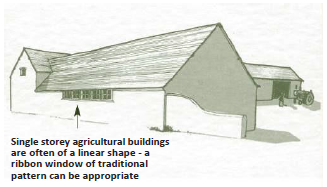
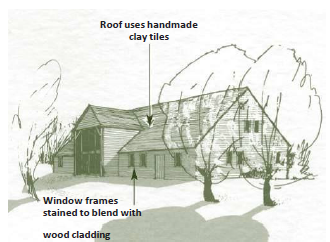
Left: Figure 9.11: Window design responds to building character. Right: Figure 9.12: Materials used in the conversion respond to the traditional building
Timber
9.1.18 Timber frames should be preserved as completely as possible, scarfing new timber to old is preferred rather than replacement. Roof trusses should remain unaltered and if possible visible. Rough sawn boarding used to clad farm buildings should be of traditional size (225mm with 37mm overlap) and not smooth profiled modern types (usually 150mm or less). Wood types should be matched. Oak is normally used for structural elements and tar coated elm for weatherboards.
Extensions and additions
9.1.19 Farm buildings are operational structures, generally without ornament or symmetry. They have a functional simplicity which is part of their appeal. Changes to the roof slope, amendments to the eaves line and the addition of porches will contribute to complexity and a loss of original character. It is important that farm buildings are preserved in their original form without alien additions or alterations.

Left: Figure 9.13: Extensions to the original building will normally be resisted. Right: Figure 9.14: Alteration of principal elevations will also normally be resisted.
Rainwater goods
9.1.20 Rain was often allowed to run off the eaves of farm buildings without a roof drainage system. It follows that new rainwater gutters and downpipes should be discrete and mounted using stirrup brackets rather than a fascia board. Rainwater downpipes should be minimised on less prominent elevations where possible and made of metal (preferably in a traditional design) rather than plastic.
Chimney stacks
9.1.21 The addition of chimney stacks can change the agricultural appearance of farm buildings by creating a domestic image. Where no chimney exists then a small metal flue finished in black or dark grey will be acceptable provided that it is set away from prominent facades or otherwise located inconspicuously.
Heating
9.1.22 The use of conventional central heating causes movement in timber framed buildings, due to the high surface temperatures of radiators. Underfloor, low temperature heating or fan convector heaters are kinder to timber flooring which have been exposed to ambient weather conditions for years. Specialist heating engineers or consultants will be required to advise on installation and maintenance.
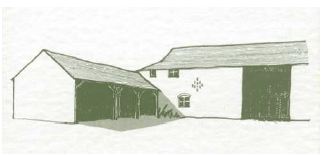
Figure 9.15: Where appropriate outbuildings should be part of conversion schemes
Interiors
9.1.23 Design solutions will have to be found which avoid disturbing the existing roof timbers and which do not require raising external walls. Conversion work needs special skill and consulting designers who have a proven record of success in this field is recommended.
9.1.24 Traditional farm buildings will most effectively retain their integrity if the interior is left open, or at least in part, to give an impression of the pre-converted space. Open plan designs within which the roof structure can be appreciated from the ground floor are preferred. Open layouts help natural light penetrate from a limited number of openings to illuminate a relatively large area of floor space.
9.1.25 Internal divisions should be kept to a minimum and in sympathy with the structural bay divisions of the building. Where appropriate staircases and doors should be contemporary in design. The removal, cutting through or disturbing of framing members should be resisted, new walls and partitions should avoid encasing the frame and, where necessary, a colourless fire resisting coating should be applied directly.
Principle DES65: The curtilage of agricultural conversions should respond to its' rural context
Consideration must be given to the curtilage of the agricultural conversion. Traditional farm buildings are generally associated with yards or open field locations. In order to maintain the agricultural character of converted buildings in their new use, they should retain their open setting and relationship with the countryside. Traditional materials that are contextual with the farm buildings should be used including stone setts, clay bricks or gravel and avoiding tarmac or concrete blocks or paving. Existing trees and plants should be retained where possible and new planting should generally be native species.
Car parking should be concealed wherever possible and existing ancillary buildings should be used as garaging to avoid the need for new buildings. Conversions should not subdivide historic farmyards.
Landscaping and boundary treatments need careful attention and should be designed to be as simple as possible. Hard and soft landscaping should be kept informal, and walls, fences, kerbing and any other urban features should be avoided where they would harm the building's agricultural character or farmyard setting.
Reason
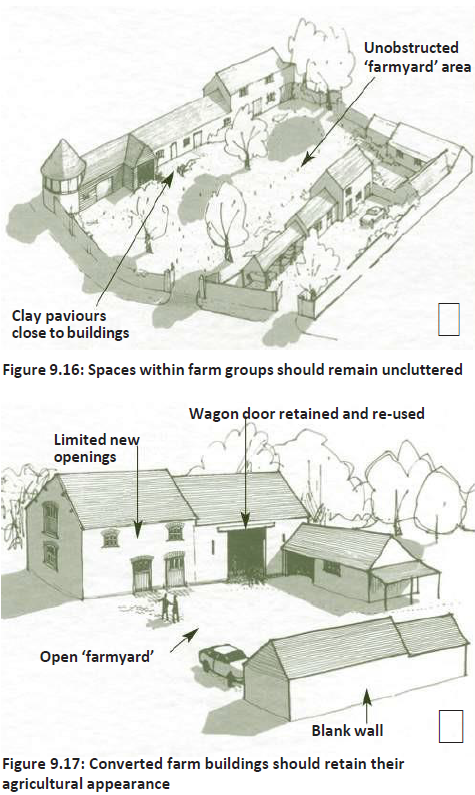 9.1.26 Farm buildings are simple and unfussy, suburban paraphernalia (patio equipment, interwoven fencing, greenhouses, pools and sheds) can detract from their farm like setting. The curtilage of a converted farm building should remain open and uncluttered.
9.1.26 Farm buildings are simple and unfussy, suburban paraphernalia (patio equipment, interwoven fencing, greenhouses, pools and sheds) can detract from their farm like setting. The curtilage of a converted farm building should remain open and uncluttered.
9.1.27 There may be scope for private areas but these should be screened with hedging and walls of old brick. The treatment of boundaries should reflect the building's rural character, post and rail fences, timber gates of the five bar type or hedgerows will be encouraged.
9.1.28 Cars and other vehicles detract from the appearance of farm yards causing them to look domestic. Parking and garaging should be concealed as far as possible. The council will expect that existing cart sheds should be re-used to garage vehicles provided that access arrangements are suitable for modern requirements. The council is reluctant to accept new structures for garaging when suitable accommodation for vehicles exists, not all buildings will therefore be available for residential conversion.
9.1.29 Refer to Historic England Advice Note 10 Listed Buildings and Curtilage.

Left: Figure 9.18: Existing features on buildings and in space that give character should be retained. Centre: Figure 9.19: Farms would not originally have prestigious entrances of non-indigenous trees and these feel out of place. Right: Figure 9.20: Open cart sheds should be used for car parking and not converted for residential use.
9.2 Conversion of chapels, schools and churches
Principle DES66: Conversion of chapels, schools and churches
The primary objective of all conversions of chapels, schools and churches must be to retain the character and appearance of the original building.
Where conversion to residential uses is proposed this may require compromises in terms of the residential layout and the provision of natural light into all habitable rooms.
The introduction of conspicuous domestic features such as chimneys, satellite dishes, aerials, porches and additional window or door openings tend to be out of character with the original building and, wherever possible, such features should be avoided.
Existing openings in elevations should be used for windows and doors and a simple window design is usually most appropriate.
The internal wall divisions should be retained wherever possible and the introduction of additional walls or floors should be kept to a minimum. Existing window openings and window detailing, such as stained glass, should be retained and refurbished.
When converting a building to domestic use it is important that the design and materials used enable sufficient noise insulation. This is particularly important when a building conversion creates a mix of domestic and commercial uses in close proximity.
Where additional floors are introduced, they should not cut across tall windows in such a way as to be visible from outside the building or significantly affect the spatial qualities.
Large extensions or ancillary buildings are not usually appropriate for conversions. Such elements can dominate the original building and so detract from its character.
Any existing ecclesiastical fixtures and fittings should be retained wherever possible, and the inclusion of additional detailing which would detract from the character of the building should be avoided.
Landscaping and boundary treatments should be designed to be as simple as possible.
Paint colours and finishes should be chosen to reflect the character and appearance of the building.
Chapel, school and church buildings can support protected species such as bats and barn owls. Bats and their roost sites are highly protected under the Wildlife and Countryside Act 1981 (as amended) and The Conservation of Habitats and Species Regulations 2017. Barn owls are protected against disturbance whilst they are nesting. Applications will need to be supported by appropriate surveys
Reason
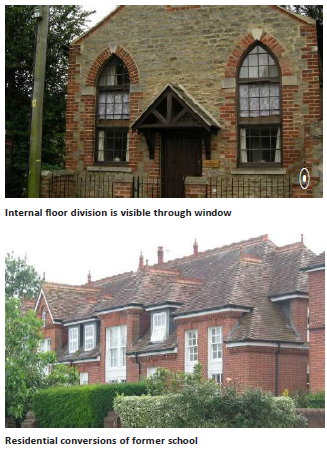 9.2.1 Similar to agricultural conversions, the design challenges associated with the conversion of these buildings often relate to the creation of room and floor divisions in buildings which originally comprised large internal spaces.
9.2.1 Similar to agricultural conversions, the design challenges associated with the conversion of these buildings often relate to the creation of room and floor divisions in buildings which originally comprised large internal spaces.
9.2.2 The defining characteristics of chapels, schools and churches are often similar, comprising formal proportions and a simple rectangular footprint, tall sash windows, brick or stone arches, uninterrupted roof slopes, long ridge lines, and large internal spaces,
sometimes with mezzanine floors. Architectural detailing may include stained glass windows, ornate timberwork and plasterwork on walls and ceilings, and ecclesiastical memorials. These features are essential to the building's character and, therefore, need to be retained as part of the proposed conversion.
9.2.3 Chapels, schools and churches are typically located in central village locations. The buildings often include limited external space as part of the site, which can present a challenge in terms of providing amenity space and minimising any overlooking of neighbouring dwellings for residential conversion.
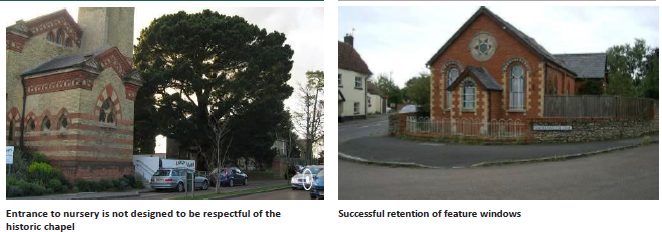
9.3 Commercial building conversions
Principle DES67: Conversion of commercial buildings
The primary objective for conversion of historic commercial buildings must be to retain the character and appearance of the original building. For conversion of office buildings to residential uses the objective is to deliver a building that has architectural integrity and to provide acceptable homes for future residents.
Where conversion to residential uses is proposed this may require compromises in terms of the residential layout and the provision of natural light into all habitable rooms. Office buildings are typically deeper plan than residential buildings and rely on artificial lighting and air conditioning for ventilation; developers should demonstrate how these issues may be overcome in the design of the conversion.
The introduction of conspicuous domestic features such as chimneys, satellite dishes, aerials, porches and additional window or door openings may be out of character with the original building and, wherever possible, such features should be avoided. If additional light is required, it may be appropriate to introduce glass roof tiles or appropriately designed rooflights.
For historic conversions internal walls should be retained and the introduction of additional walls or floors should be kept to a minimum. Existing window openings and detailing should be retained. Where additional floors or mezzanines are introduced, they should not be visible through windows. For conversion of office buildings internal layout should relate to the fenestration.
When converting a building to domestic use it is important that the design and materials used enable sufficient noise insulation. This is particularly important when a building conversion creates a mix of domestic and commercial uses in close proximity.
Large extensions or ancillary buildings are not usually appropriate for historic conversions. Such elements can dominate the original building and so detract from its character. Wherever possible, existing ancillary buildings such as storage sheds should be used as garaging to avoid the need for new buildings
Existing commercial or industrial fixtures and fittings should be retained wherever possible. Original features such as internal metalwork can make a positive contribution to the final scheme. The introduction of additional detailing, which would detract from the character of the building, should be avoided.
Landscaping and boundary treatments need careful attention and should be designed to be as simple as possible and should respond to the character and materials of the building being converted. Walls and fences should be avoided where they would harm the building's character or setting.
Commercial buildings can support protected species such as bats or birds. Bats and their roost sites are highly protected under the Wildlife and Countryside Act 1981 (as amended) and The Conservation of Habitats and Species Regulations 2017. Applications will need to be supported by appropriate surveys.
Reason
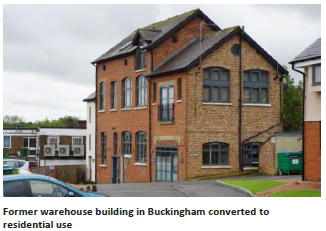
9.3.1 Commercial buildings in Aylesbury Vale include shops, pubs, mills and warehouses. In Aylesbury town centre there are also former office buildings and some of these have been converted from office to residential often through permitted development rights.
9.3.2 These larger buildings are often converted into self-contained flats which have additional amenity, parking and storage requirements that should be considered at the outset of the design process.
 9.3.3 Where a property is being converted to flats, the development should, where possible, be contained within the existing building envelope. If extensions are necessary, for example to accommodate a lift or to meet building regulations, proposals need to be carefully designed.
9.3.3 Where a property is being converted to flats, the development should, where possible, be contained within the existing building envelope. If extensions are necessary, for example to accommodate a lift or to meet building regulations, proposals need to be carefully designed.
9.3.4 Whilst pubs and shops usually have a domestic scale and design, industrial buildings such as warehouses are usually much larger, with a more formal architectural composition.
9.3.5 The defining characteristics of these industrial buildings include formal proportions usually in a rectangular plan, and large windows (i.e. plate glass in iron frames with top-hinged openings, small pane timber sash windows or Crittall Windows).
9.3.6 For office to residential conversions it is important to maintain a simple architectural formality through the pattern of window openings and where possible to introduce a vertical rhythm to the facade.
How to use
This table provides a checklist for use by both the applicant and planning officer to check that appropriate consideration has been given to the design of a building conversion as part of an application.
PROCESS: Have you read, understood and applied the principles set our above?
The adjacent table summarises the key principles set out within this section and can be used by applicant and officer as a checklist.
Applicants will be expected to demonstrate to the Council that they have responding adequately to all relevant principles in preparing their proposals, or provide a justification for any failure to do so.
|
PRINCIPLE |
DESCRIPTION |
CHECK |
|
DES64: Agricultural buildings |
Has a structural report been submitted with any planning application to demonstrate that the building is capable of conversion without substantial rebuilding or extension? If substantial rebuilding or extension is required, it is unlikely that planning permission will be granted as the proposed works would no longer constitute a conversion. |
|
|
Does the conversion retain the character and appearance of the original building as established in the Character Study? The introduction of conspicuous domestic features should be avoided. |
||
|
Has the conversion used the existing openings in elevations for windows and doors? New windows or doors should be added sparingly and should not significantly alter the overall proportion of solid wall to openings. A simple window design is usually most appropriate. |
||
|
DES65: Curtilage of agricultural building |
Does the curtilage of the agricultural building respond to its context? Do the landscape, boundary treatments and access roads reflect the agricultural character of a farmyard setting? |
|
|
DES66: Chapels, schools and churches |
Does the conversion retain the character and appearance of the original building as established in the Character Study? The introduction of conspicuous domestic features should be avoided. |
|
|
Has the conversion used the existing openings in elevations for windows and doors? New windows or doors should be added sparingly and should not significantly alter the overall proportion of solid wall to openings. A simple window design is usually most appropriate. |
||
|
If additional floors are introduced, do they avoid cutting across tall windows? |
||
|
Are existing ecclesiastical fixtures and fittings retained wherever possible? |
||
|
Does the curtilage of the building respond to its context? Is the landscape and boundary treatments designed in a simple manner that does not detract from the building? |
||
|
DES67: Commercial buildings |
Does the conversion retain the character and appearance of the original building (where appropriate) as established in the Character Study? The introduction of conspicuous domestic features should be avoided. Where this is not appropriate has the building been designed with architectural integrity (refer also to Principle DG38) |
|
|
Has the conversion used the existing openings in elevations for windows and doors? New windows or doors should be added sparingly and should not significantly alter the overall proportion of solid wall to openings. A simple window design is usually most appropriate. |
||
|
Are existing commercial or industrial fixtures and fittings retained where appropriate? |
||
|
Does the curtilage of the building respond to its context? Is the landscape and boundary treatment designed in a simple manner and in keeping with the industrial or commercial aesthetic? |
||
|
All Conversions |
Has a survey been carried out to assess the presence of bats or birds? |





